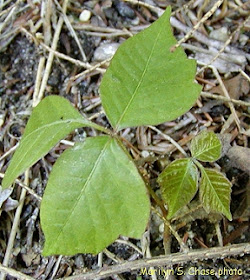Poison ivy (Toxicodendron radicans) is a North American native plant which produces urushiol, a clear liquid that causes itching, irritation and rash in most people who come in contact with it. It comes in several forms: a trailing vine, a small shrub, or as a climbing vine.
Just a couple highlights from the University of Connecticut's Integrated Pest Management site:
- Compound leaves are made up of three leaflets on a leafstalk. Two leaflets grow on opposing sides and the third stands alone at the end of the stalk. Leaflets can be lobed, smooth or toothed. Leaflets can have hairy undersides. The stems are woody.
- Poison ivy can grow in the open, in deep shade, or along pathways and roadways.
- Foliage in the spring is reddish and shiny. Flowers can appear as a cluster of greenish flowers. Fruit is white and waxy like mistletoe. Foliage in summer can be dull or glossy green. Fall foliage is yellow, red or orange.
- Poison ivy is persistent (boy, do we who have dealt with poison ivy know this!). Birds eat the fruit and drop the seeds, which germinate easily wherever they land. Creeping rootstocks also put out new growth.
- Urushiol, the toxic substance for us humans, is in the stems, leaves, fruit, flowers and roots. It is present in all plants at all times of the year in about the same strength. It is released by any bruising of any of the plant parts. Skin contact usually causes an allergic reaction. It can contaminate people indirectly by contact through clothing, garden tools, pets, or by inhaling smoke from a fire where it is burnt. Urushiol remains potent for a couple weeks; longer if it is dryer.
- Symptoms - itching, burning, swelling, rash with watery blisters - appear hours to several days after exposure. A person cannot contract poison ivy from touching the actual rash or fluid from the blisters. It cannot spread from one part of the body to another. However, urushiol can remain on skin or clothing or a pet's fur, and be then transferred to another person.
- Control is often difficult. You must dispose of the entire plant for it to be effective. Cut vines and pull them away from trees. Dig up roots. Mow or cut young shoots until the plant dies. Do not burn the poison ivy, but dispose of it where it cannot contaminate people or animals. Cover as much skin as possible with protective gloves and clothing. Clothing and tools should be cleaned to prevent the spread of urushiol.
The Wall Street Journal reported on a study that found that leaf size and oil content of poison ivy is much higher since the 1950's. So let's say one good thing about poison ivy: since poison ivy absorbs more CO2 as its leaves become larger, maybe it is helping to combat climate change...
Other good news: nobody but us humans seem to react to the urushiol - many animals eat poison ivy as part of their diet.
And that's enough good news for this time. Let's be careful out there!


No comments:
Post a Comment